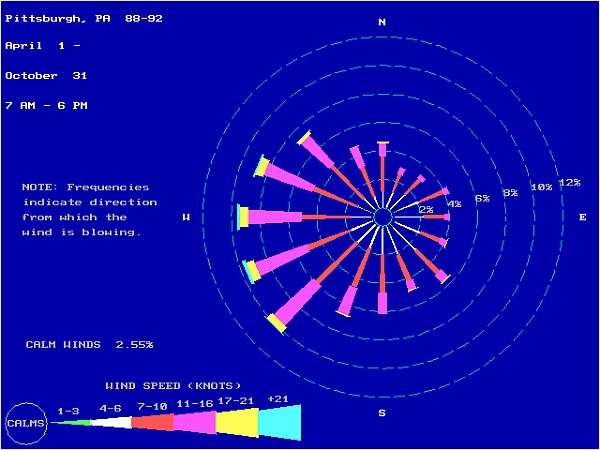
8 August 2012
Except during storms, Pittsburgh is not a very windy place. This is especially true in July and August when our average wind speed drops to 9 mph and is usually from the west.
The direction of the “usual” wind is called the prevailing wind and it shapes our weather, rainfall, landscape and vegetation.
In places where the wind is strong the prevailing wind can be seen even when it isn’t blowing. Witness the trees in the photo above at Cardigan Bay in Wales.
On a global basis the prevailing wind is influenced by the earth’s rotation. As the earth spins the atmosphere swirls in a consistent way:
- From the equator (0o) to latitude 30o north and 30o south the prevailing winds are from the east. These are the trade winds that brought Christopher Columbus and cattle egrets(*) to the New World.
- From latitudes 30o to 60o the prevailing wind is from the west. The westerlies returned the trading ships to Europe.
- From latitudes 60o to the poles the prevailing wind is again from the east.
At any given point on earth the prevailing wind might not obey these rules due to location at a border latitude (30o, 60o), topography, or seasonal change.
Pittsburgh, at 40oNorth, has no stark topography so our prevailing wind obeys the general rule: it’s from the west or WSW.
We can see this on a wind rose that plots wind direction over time. Each data point is placed at its compass position. The more data points from that position, the longer the ray from the center.
Here’s a Pittsburgh wind rose from EPA showing our daytime wind for the seven months of ozone season (April 1 to October 31).

Click here to see a wind rose depicting 30 years of data on Pittsburgh’s wind direction and here for the wind roses of 11 secondary airports (smaller towns) in Pennsylvania.
And what’s the wind like for those trees in the photo above? Right now it looks like this (scroll down to see the label “Cardigan Golf Club” and watch the wind swirl around the UK).
* Cattle egrets are originally from Africa. They flew to South American on their own — perhaps in a strong storm carried by the prevailing winds — the trade winds.
(photo of wind-shaped trees by Rudi Winter from Wikimedia Commons. Wind rose from epa.gov. Click on the captions to see the originals.)
Here is another interesting wind map, an animated map of the current wind direction and strength around country, with the ability to zoom in (click the mouse in your area):
http://hint.fm/wind/
Enjoy.
This same “Prevailing Wind” effect can be seen much closer to home atop Spruce Knob, WV. We visited there in 1983 when the kids were small and they were amazed at the way the trees and shrubs looked near the top. Some even looked like ground cover instead of trees.
Response to earnhardt3fan:
Even better than Spruce Knob, I think, is Dolly Sods Wilderness, which isn’t that far from Spruce Knob, and closer to Pittsburgh. The tree “flagging” is very pronounced there, because it’s right on the western edge of the Potomac valley region at the eastern edge of the Alleghenies, where the westerly wind drops into the valley. It’s also a great place to hawk watching in fall migration, especially at Bear Rocks.